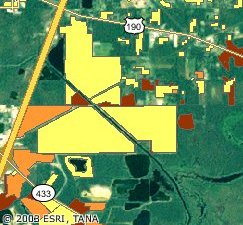Since Katrina hit I've reached representatives from Autodesk, ESRI, Intergraph and MapInfo about their work in the rescue and recovery experts.
Autodesk
I caught Jon Hansen from Autodesk on Wednesday, just as he was leaving for Pensacola, Florida then Gulfport, Mississippi and eventually New Orleans.He outlined how first responders tackle this sort of situation.The primary searches, which are mostly complete as I write on September 7, are "house to house," and may depend only on whatever print maps are available as guides.He pointed out that sometimes the map book in the fire truck can be the first, best tool for this sort of work.Those in the field will mark up these paper maps with what they see, but mostly they are focused on rescue work.
The secondary search, which is just beginning, is more methodical.The best maps for this type of work are detailed street maps that include structure footprints.The most local data would typically be the best.The goal for this round of searches is to identify hazards and pinpoint bodies."For structures that don't have addresses," Hansen noted, "responders create them." The tool of choice: a GPS receiver.In many ways, this secondary search is a data creation task.
I asked Hansen about the offers of complimentary software and tools that accompany each disaster.While he said emergency response personnel certainly appreciated those offers, he pointed out that the first responders don't have the time to learn new systems.They need to have the simplest, most focused applications in hand for the work they do.He did note that when new demands come up in the field, it may well spawn a new tool that might be available for the next incident.Is that cycle yet quick enough to put new tools in the hands of first responders during an effort? Not quite yet.
I noted the large amount of geodata, specifically imagery, now available to not just those responding to Katrina, but those watching from the side lines.How valuable would that be to responders in the field? Hansen explained that, just like software that was new or overly complex, data sets could also be "too sophisticated." He did not mean to suggest that the responders couldn't make sense of the data, but rather, that it would distract from the task at hand.The data and applications "must be user friendly and be usable in the field" as he put it.
Hansen, who calls upon his personal experience as Fire Chief in Oklahoma City for 27 years, and responded to the 1995 bombings and the 1999 tornado, helping on the ground in NYC after 9-11 and watching the recent tsunami, feels there is progress being made in presenting first responders with what they need.He's particularly pleased that it is relatively easy to use a single interface to jump between GIS data to CAD data detailing building floor plans, to utility data, to below ground views.Putting that data in a vehicle with a pen or touch screen is a huge step forward, he notes.Then what are the limitations? Providing the most appropriate data (in terms of timeliness, complexity and format) and the most efficient user interface.
Autodesk offers a variety of resources for those responding to wishing to help.
 |
ESRI
Mike da Luz, ESRI's solutions manager for forestry, fire and disaster management, was quite busy when I reached him last week.The company has been providing temporary key codes and insuring users have the software and data they need.ESRI has spent a good deal of time coordinating data and imagery and developing portals and Web contacts.
ESRI staff is working onsite with other practitioners to bolster the damaged Emergency Operations Center in Mississippi.Technical staff from Charlotte and San Antonio was on its way to impacted sites in the area to assess needs and provide resources.
ESRI was aiding the National Guard, FEMA, the Red Cross and the Forest Service.da Luz felt sure the scope of ESRI's and other's involvement would only grow in the coming days and weeks.
ESRI has set up part of its website to provide data, resources and opportunities to volunteer (via GISCorps) and an RSS newsfeed.There's also a customized data viewer.
Intergraph
I spoke with Intergraph spokesperson Rita Roberts during the days since the hurricane hit.She explained that the lack of land line phones, cell phones and Internet made tracking down users in the impacted areas nearly impossible early on.But the company has been able to talk with most of their customers in the Gulf region to provide whatever assistance is needed.Several partners had lost offices.One was lucky that its aerial camera was off-site during the storm and safe.Several users have reported that they will certainly need help, but exactly what will be needed is still to be determined.
Intergraph is reaching out in many different ways.Intergraph is insuring its employees' safety.Several lived in the affected region.The company has also committed technical resources, software, facilities and hardware to help businesses that depend on Intergraph products to get up and running as soon as possible - shipyard, 911, oil & gas, local government and other customers affected by the disaster.Louisiana State University (LSU) is becoming one of the primary information hubs for geospatial information used by FEMA and other relief agencies.Intergraph has technical implementation resources on site and is contributing GIS/geospatial technology at LSU.The company announced a matching program for employee contributions up to $50,000.Intergraph is also contributing another $50,000 to various relief agencies.
Those looking for help can find contact information online.
MapInfo
MapInfo is supplying Louisiana with free software upgrades and additional licenses to help it cope with the Hurricane Katrina aftermath.The company has also made similar offers to other state and federal agencies.Company spokesperson Angela Girard explained that the Louisiana Department of Health was an existing user but that it lost much of its data when the storm waters breached levees and flooded New Orleans.The Federal Emergency Management Agency is also a user.
MapInfo provides a webpage describing the help it can offer.